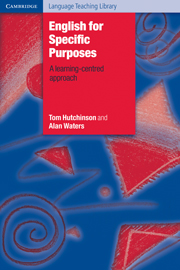Book contents
7 - Approaches to course design
Published online by Cambridge University Press: 03 May 2010
Summary
They must have the defects of their qualities.
(translated from Honore de Balzac: Le Lys dans la Vallée)Course design is the process by which the raw data about a learning need is interpreted in order to produce an integrated series of teaching-learning experiences, whose ultimate aim is to lead the learners to a particular state of knowledge. In practical terms this entails the use of the theoretical and empirical information available to produce a syllabus, to select, adapt or write materials in accordance with the syllabus, to develop a methodology for teaching those materials and to establish evaluation procedures by which progress towards the specified goals will be measured.
So let us assume we have completed our needs analysis and reviewed the theoretical models of learning and language available. We now have to face that crushing question: What do we do with the information we have gathered? Asking questions about learner needs will not of itself design a course. The data must be interpreted. We have got a lot of answers. But when we come to designing our course, we will find yet another series of questions. The data from our needs analysis can help to answer these questions. But care is needed: there is no necessary one-to-one transfer from needs analysis to course design. We have seen already that answers from one area (what learners need) and another (what learners want) may conflict. We must remember that there are external constraints (classroom facilities/time) that will restrict what is possible. There are also our own theoretical views and (not to be discounted) experience of the classroom to take into account.
- Type
- Chapter
- Information
- English for Specific Purposes , pp. 65 - 78Publisher: Cambridge University PressPrint publication year: 1987



